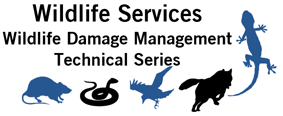U.S. Department of Agriculture: Animal and Plant Health Inspection Service
Date of this Version
9-2019
Document Type
Article
Citation
Vantassel, S.M., M.W. Fall and S. Lariviére. 2019. Information Resources for Animal Control and Wildlife Damage Management. Wildlife Damage Management Technical Series. USDA, APHIS, WS National Wildlife Research Center. Fort Collins, Colorado. 20p.
Abstract
A bumper sticker reads, “If you think education is expensive, you oughta try ignorance.” That statement could not be truer in regard to wildlife damage management. Being willing to learn is a critical attitude for everyone involved in wildlife damage management. Since wildlife damage management intersects so many other disciplines, no single person can be an expert in all of them. In addition, the arrival of an invasive species, changes in building practices (e.g., egress windows, ridge vents), or the implementation of new regulations can confound traditional practices and require new control methods. Thus, it is important to provide a resource that provides detailed, updated and accurate information. Since the publication of the 1994 Prevention and Control of Wildlife Damage handbook, there has been a remarkable increase in the volume and quality of information related to wildlife damage management. The rise of the digital age has empowered people to transmit their knowledge and ideas in writing, pictures, and video. A few decades ago, local, state, and federal government wildlife biologists were the primary practitioners of animal control and damage management. Private pest management firms involved in vertebrate animal problems were primarily limited to the control of urban birds and commensal rodents. This situation has changed substantially since the 1990s.
The nuisance wildlife control industry has matured. The increased involvement of the private sector in wildlife control unleashed the creative forces of entrepreneurs in the development of new techniques and products. Until the mid-1980’s, most scientific information about wildlife damage management was scattered in articles in academic jounrals (e.g., Journal of Wildlife Management), “grey literature” (i.e., unpublished reports and conference proceedings), and government documents (i.e., U.S. Fish and Wildlife Service and Forest Service publications). Since then, wildlife damage management research has achieved greater prominence as demonstrated by the addition of new outlets and changes in publication policies. The emergence and rapid growth of the nuisance wildlife control industry has supported development of several trade magazines, association newsletters, listservs, bulletin boards, and numerous websites. A few decades ago, relevant research papers only numbered a few hundred a year, now computer search engines return thousands of hits, putting a premium on effective search strategies to obtain information. Digital copies of papers of are often available at no or nominal cost. The volume of information related to wildlife damage management is now enormous. In this publication, we have highlighted important works to supplement the sources found in the various publications of the Wildlife Damage Management Technical Series. In addition, we have focused on information resources that are easily obtained, used primarily for the North American audience, and published since 1994. Materials from journals and other publications with restricted access are mentioned only when we believe the utility of the information justifies the effort involved to obtain them. The numerous websites referenced were checked for current access during October 2019.
Included in
Behavior and Ethology Commons, Biodiversity Commons, Library and Information Science Commons, Other Animal Sciences Commons, Other Ecology and Evolutionary Biology Commons, Population Biology Commons, Terrestrial and Aquatic Ecology Commons

